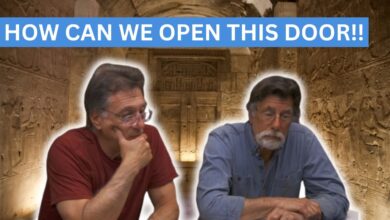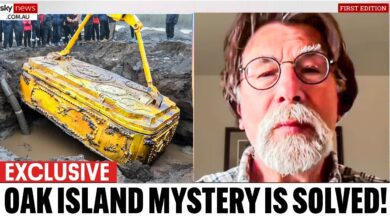Rick Lagina: “We Discovered The Treasure Hatch Today!”
Rick Lagina: "We Discovered The Treasure Hatch Today!"
The Secrets of Oak Island
You know, like right here that looks like it’s been chiseled. This is the blade part. Now again, it’s weathered a lot and it was much more defined years ago when I first saw it—about 20 some years ago—in a dim room lit by flickering lanterns. Rick, Marty, and their team crowded around an old table when Zena Halper rushed in, excitement written all over her face.
She spread out two ancient maps in a mysterious code—a decent size anomaly. I mean, it’s right next to the road that’s near where the hatch from Zena’s map is located. One map, marked with the year 1179 in Roman numerals, showed Oak Island labeled as Rodan. Zena suggested this could point to New Ross, which was linked to a historic voyage to Nova Scotia. What secrets are buried deep under Oak Island? Let us expose what’s hidden behind this alien hatch.
The Quest for Buried Secrets
Gathered around a large table dimly lit by lanterns, Rick, Marty, and their team discussed local legends with Doug. They were joined by Zena Hurn, a well-known expert on the Knights Templar, whose enthusiasm energized the group. She shared a groundbreaking discovery that might solve many of Oak Island’s mysteries.
Zena revealed two old maps along with a mysterious code. The date on the first map, written as 1179 in Roman numerals, amazed everyone. It was a series of things that correlated perfectly with the island as we know it, and then there were things that we’d never heard of. So, of course, we wanted to search for them.
Oak Island was clearly marked, lying between latitudes 46 and 47, but a strange label, Rodan, over Oak Island caught their attention. Zena believed it pointed to New Ross, a settlement connected to Henry Sinclair’s historic voyage to Nova Scotia in 1398. But this wasn’t the only surprise. Could these maps actually unlock the secrets of Oak Island’s legendary treasures?
A Renewed Determination
Zena’s discovery reignited the team’s determination, giving them new energy in their quest for answers. As they studied these ancient maps, they realized that Oak Island’s mysteries were far from being solved. With a fresh sense of purpose, the team dove into their search with renewed intensity, carefully examining every clue.
They crossed rough terrain and faced unexpected challenges. The bond between Rick, Marty, and their team members deepened as they shared a common passion and a firm belief in the hidden depths of Oak Island. As they delved further, they discovered that Oak Island in Canada might be linked to the Knights Templar, a powerful group from the past.
Some believe that a Templar fortress was built there in the 1300s by a Scottish noble, Prince Henry Sinclair. But recent discoveries suggest an even more interesting story. Zena Halper found evidence that the Templars might have been on Oak Island long before Sinclair, which could change the history of the nearby New Ross and its connection to the Templars.
Zena’s maps are key to this ongoing mystery, with one map showing all of Nova Scotia and another a French map from 1347 containing fascinating inscriptions that support these new theories. The records show that the French were on the island in the past; they mention a base which might be a marsh and a dam possibly found by another explorer. Interestingly, the map includes strange phrases like “Oak enter year,” pointing to a famous treasure spot on Oak Island. There are also mysterious terms on the map like anchors and valves that still haven’t been figured out. These could be clues to undiscovered secrets.
The team is excited by these maps and keeps searching for answers. Each new discovery helps them understand more about the island’s history. They’re starting to think that the island’s story might be different from what most people believe. They wonder if the Knights Templar, an ancient group, were there before Henry Sinclair. Did they leave behind clues, treasure, or maybe even a hidden fortress? But they faced a big question: was this hatch something made by humans in the past or was it an ancient relic? Finding the answer could be a huge breakthrough for the Lagina brothers in their quest to unlock Oak Island’s secrets.
Uncovering the Hatch
Lari carefully examined the hatch and noticed signs that humans had tampered with it. Some stones seemed to have been deliberately moved while others were loosely placed, hinting at a design with purpose. Marty wondered if this hatch might lead to a tunnel system. He thought one side might open into a passage, but they needed to explore further. This would mean getting the right permissions and clearing the surrounding area. But this wasn’t the only challenge. Marty was committed to following all legal rules, even asking about restrictions on using basic tools like hand shovels.
Although getting the necessary permits would slow them down, Rick and Marty agreed it was important to inform the authorities of their findings. They knew that following the rules would benefit their long-term research on the island. Rick and Marty faced new challenges: preserving the past while uncovering the future. Driven by a desire to explore ethically and scientifically, they decided to involve the Canadian government in their project.
This decision showed their commitment to respecting both the environment and the possible historical significance of Oak Island. Oak Island was more than just a place to find treasure; it was seen as a site of national and even spiritual archaeological importance. Rick and Marty wanted to honor this by preserving its value while uncovering its hidden truths. They knew it was crucial to consult with authorities to ensure the island was protected. Their approach was very different from the harsh methods used by past treasure hunters. The Lagina brothers promised to use modern technology and proper archaeological practices to conduct their search.
The Journey Continues
Their goal was to explore the island’s hidden depths while protecting its historical and natural significance. But this wasn’t the hardest part yet. On a bright morning, Rick and Marty gathered their team at the island shore, ready to meet with Dan Blankenship, a longtime expert on the island’s hidden treasures. Dan had spent nearly 50 years collecting information about the treasure, including maps, photos, and stories from those who had searched the island in the 1800s.
Dan’s house was like a small museum filled with historical artifacts. His basement was especially impressive, with shelves lined with old maps and photos, each one a small piece of the big puzzle they were trying to solve. The experience felt like a journey back in time, showing how early treasure hunters worked. More than just artifacts, Dan himself was a wealth of knowledge. He shared countless stories about the treasure hunt, tales passed down through generations. His love for the island was clear, and his tales made everyone eager to learn more. Dan served as a key link between the island’s mysterious past and the ongoing treasure hunt. His knowledge helped the team better understand the challenges ahead and increased their chances of finding hidden treasures.
In the early 1930s, a determined treasure hunter named Melvin Chappelle made a detailed map of The Money Pit area on Oak Island. He believed he had found the original pit, so he and his father William began digging a secret tunnel. They hoped this tunnel would lead them straight to the legendary treasure, but their plans were crushed when seawater from one of the island’s flood tunnels filled their dig site, ruining their efforts.
This year, Marty and Rick discovered evidence of Chappelle’s failed attempt while drilling. This find led the crew to gather and plan their next move. During this meeting, Marty voiced concerns about where to dig next. The team had a lively debate, with some members favoring a northeastern site and others leaning toward the southwestern one. This disagreement made them rethink their approach. With important equipment on the way, they felt the pressure to make quick decisions.
They chose to gather more information and have further discussions, understanding that the success of their quest relied on making the right choice. But that wasn’t the most challenging part. They were hopeful that Mike and Mark would be able to give them some information from the stones. You know, might it lead to treasure? I don’t know. Might it lead to other discovery agendas? I don’t know. We have to start somewhere, and the place to start is with the digging at The Money Pit.
While digging at The Money Pit was on hold, Rick Lagina, island historian Charles Barkhouse, and fellow explorer Jack Begley consulted stone masons Mike and Mark Fugue. They examined Nolan’s Cross, one of the island’s most intriguing features. Their main goal was to determine if the large stones had been shaped by humans. They focused on the point where the arms and stem of the cross intersected, a crucial spot due to discoveries made by Fred Nolan in 1981.
Fred had found five massive cone-shaped stones arranged in a perfectly symmetrical cross over a large area. Intrigued by this formation, he suspected something important was hidden at its center. His curiosity drove him to continue his search, eventually uncovering a sixth stone that looked like a giant human head.
The exploration of Nolan’s Cross offered the potential not just to prove human involvement but also to uncover hidden treasures or significant historical artifacts. Every stone on Oak Island tells a story, between Templar symbols and ancient mysticism. But this was only the beginning. While many believed Nolan’s Cross represented a Templar cross, another theory emerged. Some thought the stones might depict the Tree of Life, a symbol in ancient Hebrew mysticism representing 10 spiritual principles involved in the creation of the universe.
As more uniquely shaped stones were found, this new theory gained support. Stones were carefully arranged in a formation called Nolan’s Cross, perfectly matching the points of a pattern known as Sepo. Each stone had a round top and a flat face, with natural marks that seemed to resemble human faces, including eyes and mouths. As the researchers dug deeper into their study of Nolan’s Cross, they felt they were getting closer to uncovering the secrets behind the strange formation.
The idea that people might have created it, along with the possibility of hidden treasures and symbols of ancient knowledge, made everyone eager to see what they might find. The discovery of a small sword among the stones only added to the mystery. Some thought Nolan’s Cross might resemble a religious symbol and that it could be hiding something important. Experts who came to examine the rock noticed interesting features that made them wonder if Nolan’s Cross was a significant religious symbol or just an unusual geological formation.
The leaders of the project believed Nolan’s Cross could be crucial for solving the mysteries of Oak Island. As they waited for more discoveries, the idea that Nolan’s Cross might have meanings beyond just being a collection of stones was exciting. But the story doesn’t end there.
I was really interested in terms of trying to find something that connects the Stone Road to something else, right? We know it had to be used for something else, and they were going somewhere and doing something. Over the years, weather had changed the look of Nolan’s Cross. One stone in particular seemed different from the others, possibly serving a unique purpose. Rick, the leader, thought the direction of this stone might offer a clue, but they needed experts to confirm it.
Even with all these questions, Rick understood that Nolan’s Cross might not lead them to treasure or clear answers. He stressed the importance of keeping up the exploration to uncover the deeper stories of the island. Relying on expert knowledge, the team stayed committed to uncovering the full story of Oak Island, believing Nolan’s Cross was key to their search, whether or not it gave them the answers they were looking for.
The next morning, the Oak Island team inspected the base of Nolan’s Cross, where they found a massive 5-ton granite cone. This exploration aimed to understand where the stone originally stood and what its purpose might have been, offering new insights into this fascinating structure. All five granite stones at Nolan’s Cross had a similar shape, leading the team to wonder if they had found a stone that only needed slight changes or if it had been moved there on purpose.
But there’s more. It needs more digging, and until that happens, I don’t think we can assess properly what this may mean. Stonemason Mark Ferguson and Mike Welling noticed that one stone was smoother than typical natural granite, raising questions about whether it was naturally formed or shaped by human hands. This rock, located near the base of Nolan’s Cross on a property owned by Fred Nolan’s family, seemed to hold important clues. Its polished surface, unlike the roughness of the other granite pieces, suggested it had been cut and placed intentionally, adding to the mystery of the site.
Rick Lagina thought this discovery was crucial because it suggested the stones of Nolan’s Cross had been transported and set with great care. The smooth base of one particular rock stood out against the rougher parts, indicating it had been modified on purpose. But that wasn’t the end of it. These findings led to new research and theories. Could this polished stone be the key to an undiscovered structure or monument on Oak Island? Could it help explain the origin and purpose of Nolan’s Cross, revealing more about the island’s hidden past?
More discoveries await the team every day. The mystery of Nolan’s Cross continues as the crew explores the area around it. Each new discovery, no matter how small, adds more pieces to the puzzle of the island’s mysteries. Their careful and respectful approach showed their dedication to solving the puzzle of Oak Island.
A few days later, Rick Lagina met with Terry Deveau and another team member to talk about an unusual stone Terry had found—known only to a few. A year earlier, Terry had shown Rick, Craig Tester, and Dave Blankenship some ancient statues at Overton, 144 miles from Oak Island, which had a notable Christian symbol—a circular cross. This suggested a possible connection between Peggy’s Cove and Oak Island, despite the distance between them.
Terry first noticed the unusual stone about four years ago while exploring ancient sites with carved rocks. It stood out to him because it looked man-made, unlike the other stones and boulders around. This discovery sparked his curiosity and pushed him to dig deeper into what the stone might mean. As time passed, Rick, Marty, and their team found more strange stone figures around Oak Island. From New Ross to the Bedford Barrens, people started wondering if these carvings were clues to the island’s mysteries.
When they looked closely at the stone, they saw features that looked like a face facing the sea. “I’d say it’s from the early 1700s; it could be anywhere in the 1700s,” Terry noted. He noticed that smaller stones under the main one suggested it had been moved and placed there on purpose. It seemed like someone had even shaped it to emphasize the face. The stone had also been cleaned to make it stand out more. This intricately carved stone might be key to understanding Oak Island’s complex history. Terry’s find added more evidence that there’s much more to Oak Island than meets the eye.
Our team carefully analyzes each artifact and market, showing our dedication to solving these long-standing mysteries. The suspense kept building when a large steel Quon set arrived, suggesting they might uncover a wooden structure Rick and Craig Tester had spotted two years earlier. Historical documents confirmed there was wood at this exact spot, backing up their findings. Marty stressed how important it was to prove they had reached the vault they were looking for, feeling confident that a big discovery was just around the corner.
They were only waiting for confirmation that this was the vault they had been searching for. However, the Lagina brothers didn’t see eye to eye on what to do next. Marty wanted to keep digging, convinced they had found the structure, but Rick, who was more concerned about safety, thought they should stop to avoid damaging any historical or archaeological features.
Rick argued for a thorough investigation that respected the site’s history, highlighting the balance between aggressive exploration and careful preservation. “We know historically the boat’s 140 ft and we know it was 22 ft wide, so we’re going to go that way 22, we’re going to go that way 140.” Their approach showed their commitment to uncovering the truth of Oak Island.
What Lies Beneath?
What do you think? Is Oak Island truly hiding Captain Kidd’s treasure, or is it just a myth? Let us know your thoughts in the comments! Don’t forget to like and subscribe for more.



